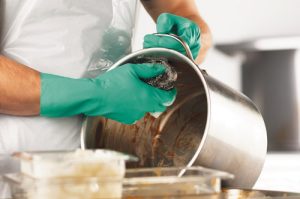Singaporeans are food lovers…hawker centers, food courts and restaurants may be among the most visited places besides our homes and offices! However, inadvertently sometimes F & B Businesses ignore the way food is handled resulting in food poisoning cases that have led authorities to cancel food licenses and even shut down some establishments.
Cleaning and Sanitation deserve utmost attention. Coz, more often than not contamination and food poisoning are majorly caused due to inadequate sanitation measures. So, if you run a food stall or happen to be a food handler (such as a chef or kitchen assistant) or simply a concerned homemaker here are five best practices you may want to implement at your home/work place.
1. Mark your Calendar, Observe a Schedule
Plan, mark dates and time slots to clean your kitchen, stall etc. If you run a food & beverage establishment, there should be a clean-up session daily, making sure to keep your supplies and equipment ready before time. Creating a schedule and following it diligently ensures bacteria, insects, pests do not enjoy time in your kitchen spaces.
2. Employing efficient methods for Cleaning and Sanitation

- Rinse your utensil under running water to wash away any leftovers or debris.
- Wash the surfaces of your utensils with appropriate detergents. (Soaking, spraying, foaming and pressure cleaning are all forms of washing).
- Flush away or clear food or dirt particles on your surfaces.
- Sanitize your utensils by steaming or rinsing in hot water or with reliable chemical cleaning solutions.
Sanitizing works best when the cleaning solutions are warm (with hot water > 77 degree Celsius) and the surface to be cleaned are in contact for a sufficient time.
Depending on type of food, sanitizing solutions should be diluted as recommended by the manufacturer.
3. Using the Right Tools
Always ensure that suitable brushes and tools are used for the job. Using coarse cleaners might cause scratches that can lead to bacterial growth if not sanitized properly. Therefore, different surfaces require different treatment. For example –
- Tough surfaces should be cleaned with stiff bristled brushes
- Soft bristled brushes should be used on dusty, fragile and scratch prone surfaces.
- Pads, sponges are soft and flexible; they should be used for utensils.
Having color coded tools for different areas makes it easier for to identify. After use, it’s vital to thoroughly clean, dry and store the cleaning equipment in hygienic conditions.
4. Practicing Personal Hygiene (e.g. Hand-Washing)
Hands can sometimes be the key source for contamination. So they should be washed – before and after preparing food, changing between raw meat and vegetables, after using the toilet, handling any waste and when you cough and sneeze into your hands.

Image Source: Good Cleaning & Sanitation Practices by AVA & NEA
Practice these 8 steps for clean hands:
- Rinse hands under clean running water, rub palms together.
- Clean between the fingers.
- The back of your hands.
- Scrub your thumbs
- The back of your fingers
- Get your fingernails
- Your wrists
- Lastly, rinse and dry your hands with paper towels/clean napkins.
5. Storage of Food & Housekeeping Materials
So far we have focused on cleaning and sanitizing. But without proper housekeeping, management and storage of food, only half your job is done.
To keep bacteria and other microorganisms from growing, it is important to store perishable goods at the correct temperature for the proper amount of time. Microorganisms are more likely to grow in the danger zone where the internal food temperature is low. Storage has to be hygienic and dry depending on the kind of food (i.e. raw or cooked vegetables and meat).
Besides food storage, hazardous chemicals used for external cleaning and maintenance such as detergents, pesticides, polishes, glass cleaners, etc should be separated out, labeled and stored in an organized manner.
It always matters, not only what you eat but also where you eat. Whether you’re a homeowner managing your own kitchen or a manager overseeing an F & B establishment, cleaning and sanitation is of paramount importance. There’s no substitute or shortcuts when it comes to implementing basic hygiene standards.

